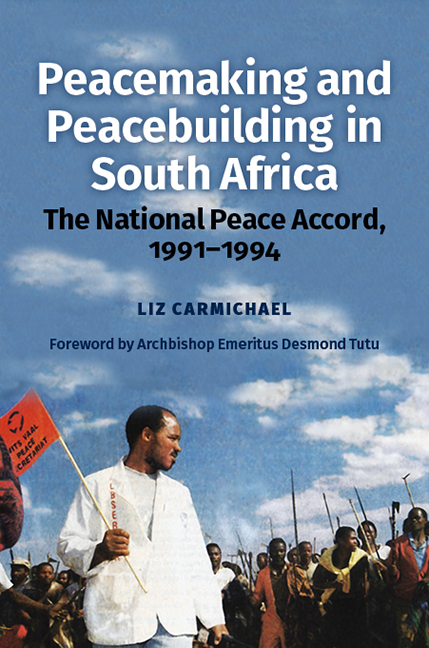Book contents
- Frontmatter
- Dedication
- Contents
- List of Illustrations
- List of Abbreviations
- Glossary
- Acknowledgements
- Note on Nomenclature
- Transition Timeline
- Foreword
- Introduction
- Part One Peacemaking, Peacebuilding, and the South African Conflict
- Part Two Peacemaking
- Part Three Peacebuilding
- Conclusion: Impact and Unfinished Business
- Bibliography
- Index
14 - Peace Monitoring: Building Peace on the Streets
Published online by Cambridge University Press: 08 October 2022
- Frontmatter
- Dedication
- Contents
- List of Illustrations
- List of Abbreviations
- Glossary
- Acknowledgements
- Note on Nomenclature
- Transition Timeline
- Foreword
- Introduction
- Part One Peacemaking, Peacebuilding, and the South African Conflict
- Part Two Peacemaking
- Part Three Peacebuilding
- Conclusion: Impact and Unfinished Business
- Bibliography
- Index
Summary
Introduction
Much pre-Accord violence stemmed from confrontations at protests, rallies and funerals. The NPA mandates the structures to promote communication and agreements between parties and security forces around such events. This enabled a new kind of peace monitoring to develop, introducing cooperative planning and preventing violent confrontation. From August 1992 International Observers joined the monitors. Training developed, and 18,500 local monitors were deployed over the election in 1994.
Sharpeville Day, 21 March 1993
And there were these two elderly white people – must have been in their late sixties I would say, and very sort of proper people, and they were in this Peace Accord car and both of them were reading books, at this intersection. They didn't know what was happening. Reading their books with their glasses on, like that.
And the IFP were coming down like this about a hundred yards away, and the ANC over here, and in the middle this couple reading their books. Oh, it was funny! I went up and tapped on the window and – ‘Oh, hello Peter!’ – and I said: ‘Have you looked what's coming down the road?’ And they looked out and it was just like a sea of armed people.
The place was ‘Kathorus’, the adjacent East Rand townships of Katlehong, Thokoza and Vosloorus, the sole remaining centre of violence in the Wits/Vaal region. It was Sharpeville Day, Sunday 21 March 1993. Ten days earlier, the Germiston/ Katlehong LPC had learnt that two rallies were planned: Chief Buthelezi would address the IFP in Vosloorus stadium while the ANC met in Katlehong stadium. The criss-crossing of armed rally-goers was a recipe for disaster.
Human rights lawyer Peter Harris had just become Wits/Vaal's Regional Director, assisted by recent law graduates Mahlape Sello and David Storey, and a strong Wits/Vaal Regional Peace Secretariat (RPS) was developing. The RPS and Vosloorus and Germiston/Katlehong LPCs held emergency meetings with the ANC, IFP, hostel indunas and police, hammering out draft agreements to facilitate the rallies while keeping supporters apart. With the Thokoza LPC Chair, they formed a Coordinating Committee under the RPC. Coordination was, however, imperfect: the International Observers later castigated the RPS for over-riding early agreements made on the LPCs based on close familiarity with local conditions.
- Type
- Chapter
- Information
- Peacemaking and Peacebuilding in South AfricaThe National Peace Accord, 1991-1994, pp. 290 - 328Publisher: Boydell & BrewerPrint publication year: 2022



